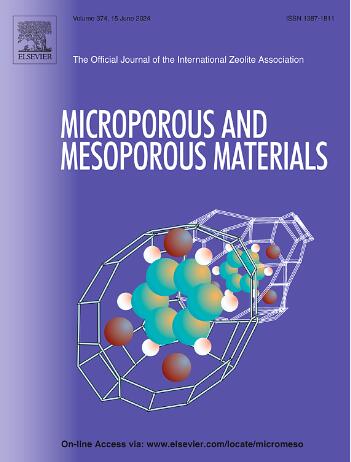Development of mesoporous biocatalysts synthesized from a biomass surfactant for flavorings production
IF 4.8
3区 材料科学
Q1 CHEMISTRY, APPLIED
引用次数: 0
Abstract
Obtaining flavorings industrially requires extreme conditions such as high temperatures and pressures, operation of toxic solvents, and use of acids as catalysts. Given these limitations, more eco-friendly alternatives like enzymatic catalysts are being investigated. However, the enzymes stability in organic reagents and reuse are the main drawbacks; therefore, the use of immobilization techniques on novel inorganic supports would allow combining the enzymatic selectivity and the properties of these matrices to increase their catalytic performance. In the present work, the transesterification reaction of vinyl acetate with isoamyl alcohol to produce isoamyl acetate was conducted at 40 °C and atmospheric pressure using a mesoporous biocatalyst synthesized from a biomass-derived molding agent. The synthesized materials were characterized by N2 adsorption and desorption isotherm, Transmission Electron Microscopy (TEM), Scanning Electron Microscopy (SEM) and Infrared Spectroscopy (FT-IR). For the biocatalyst synthesis, the enzyme-support contact times and the enzyme loading were evaluated. The best catalytic performance was obtained with a material prepared with 96 h of immobilization and with a theoretical loading of 400 mglipase/gsupport. High vinyl acetate conversion (86 %) and isoamyl acetate yields (62 %) were achieved at 40 °C after 20 h of reaction. The results suggest that the lipases immobilization on renewable mesoporous silica offers a promising alternative route for the sustainable fragrances production under mild operating conditions.

生物质表面活性剂合成香料用介孔生物催化剂的研制
工业上获得调味品需要极端的条件,如高温高压,有毒溶剂的操作,以及酸作为催化剂的使用。考虑到这些限制,人们正在研究更环保的替代品,如酶催化剂。然而,酶在有机试剂中的稳定性和重复使用是主要的缺点;因此,在新型无机载体上使用固定化技术可以结合酶的选择性和这些基质的性质来提高它们的催化性能。在本研究中,使用由生物质来源的模塑剂合成的介孔生物催化剂,在40°C和常压下进行了醋酸乙烯酯与异戊醇酯交换反应生成醋酸异戊酯。通过N2吸附和脱附等温线、透射电镜(TEM)、扫描电镜(SEM)和红外光谱(FT-IR)对合成材料进行了表征。对于生物催化剂的合成,酶载体接触次数和酶负载进行了评价。固定化时间为96 h,理论负载量为400 mglipase/gsupport时,催化性能最佳。在40℃条件下反应20 h,乙酸乙烯酯转化率达到86%,乙酸异戊酯收率达到62%。结果表明,在温和的操作条件下,可再生介孔二氧化硅上固定化脂肪酶为可持续生产香料提供了一条有前途的替代途径。
本文章由计算机程序翻译,如有差异,请以英文原文为准。
求助全文
约1分钟内获得全文
求助全文
来源期刊

Microporous and Mesoporous Materials
化学-材料科学:综合
CiteScore
10.70
自引率
5.80%
发文量
649
审稿时长
26 days
期刊介绍:
Microporous and Mesoporous Materials covers novel and significant aspects of porous solids classified as either microporous (pore size up to 2 nm) or mesoporous (pore size 2 to 50 nm). The porosity should have a specific impact on the material properties or application. Typical examples are zeolites and zeolite-like materials, pillared materials, clathrasils and clathrates, carbon molecular sieves, ordered mesoporous materials, organic/inorganic porous hybrid materials, or porous metal oxides. Both natural and synthetic porous materials are within the scope of the journal.
Topics which are particularly of interest include:
All aspects of natural microporous and mesoporous solids
The synthesis of crystalline or amorphous porous materials
The physico-chemical characterization of microporous and mesoporous solids, especially spectroscopic and microscopic
The modification of microporous and mesoporous solids, for example by ion exchange or solid-state reactions
All topics related to diffusion of mobile species in the pores of microporous and mesoporous materials
Adsorption (and other separation techniques) using microporous or mesoporous adsorbents
Catalysis by microporous and mesoporous materials
Host/guest interactions
Theoretical chemistry and modelling of host/guest interactions
All topics related to the application of microporous and mesoporous materials in industrial catalysis, separation technology, environmental protection, electrochemistry, membranes, sensors, optical devices, etc.
 求助内容:
求助内容: 应助结果提醒方式:
应助结果提醒方式:


